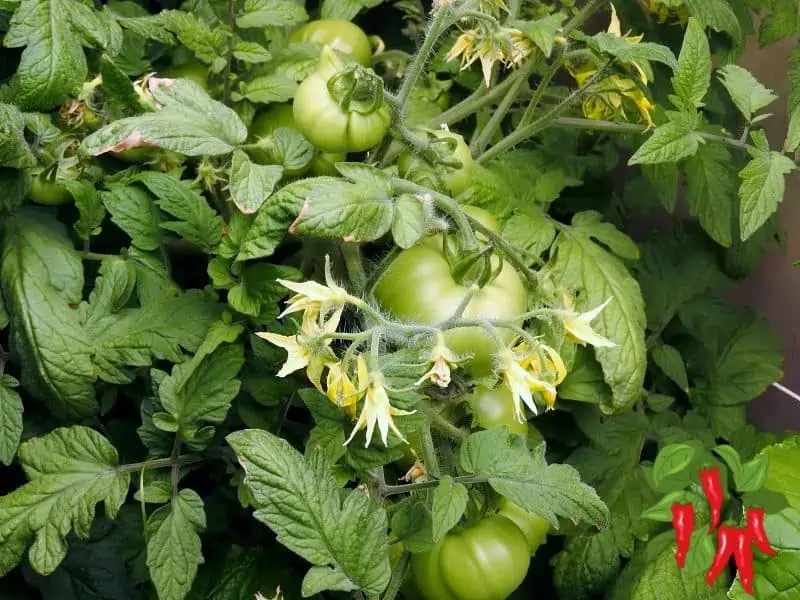This post may contain affiliate links. If you buy something from one of our links we may earn a commission. Thanks
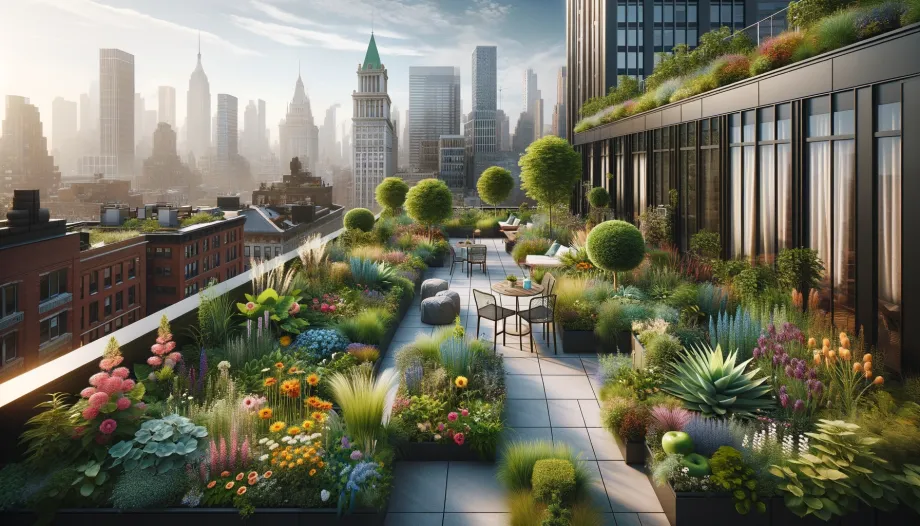
Discover creative rooftop gardening ideas for transforming your urban space into a lush oasis. Learn tips, tricks, and the best plants for rooftop greenery!
Growing a Rooftop Garden Key Takeaways:
- Growing a rooftop garden involves selecting wind and sun-resistant plants, using lightweight soil, and ensuring proper water management.
- It’s a sustainable way to beautify urban spaces, reduce heat, and improve air quality, turning underused roofs into vibrant green areas.
Ever thought about bringing a slice of nature to your urban dwelling?
Our guide to rooftop gardening ideas is here to show you how to turn your roof into a thriving green paradise.
Join us as we explore the best ways to cultivate beauty and tranquility, high above the city hustle!
Introduction to Rooftop Gardening Ideas
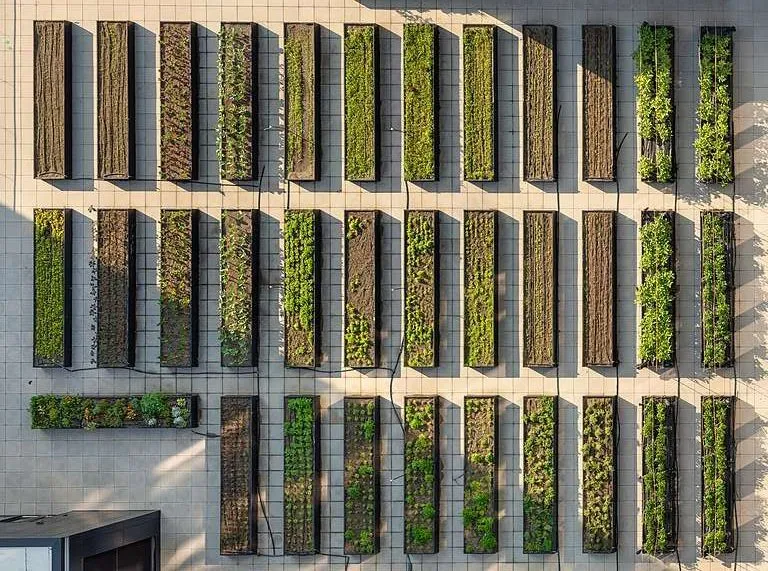
Rooftop gardening is a blossoming trend that combines urban living with the joy of gardening.
In cities where space is a luxury, converting a barren roof into a lush garden offers a private oasis amidst the concrete jungle.
This guide will explore various roof garden ideas, from vegetable patches to decorative terraces, and discuss the nuances of creating a thriving garden in the sky.
Whether you have a spacious rooftop or a small terrace, there are innovative ways to cultivate a green space that suits your style and space.
Derived from the broader concept of Green Roofs, Rooftop Gardens are a specialized and innovative way to combat the lack of green spaces in urban areas, while also providing locally grown produce.
Rooftop Gardens provide a solution to efficiently use unused spaces where vegetation can provide shade and release excess water into the air, through a process called transpiration. UMass Lowel
What Plants Can Grow on a Rooftop Garden?
The secret to a flourishing rooftop garden lies in selecting the right plants that can adapt to the unique rooftop environment.
This section explores a variety of plants, including vegetables, that are well-suited to rooftop conditions, focusing on their resilience to sun, wind, and other urban elements.
Sun and Wind Resistant Plants:
-
- Hardy Shrubs and Small Trees: Such as juniper, dwarf pine, and some varieties of maple, can endure the windy and sunny conditions.
- Ornamental Grasses: Tall grasses like feather reed grass or blue oat grass can add texture and movement to your garden while being resilient.
- Flowering Plants: Certain flowering plants, like coneflowers and lavender, are known for their ability to thrive in sunny, windy environments.
Drought-Tolerant Species:
-
- Succulents: Plants like sedums and sempervivums are perfect for rooftop gardens due to their low water requirements and ability to withstand full sun.
- Mediterranean Herbs: Rosemary, thyme, and oregano not only add flavor to your dishes but herbs adapt well to the drier conditions of a rooftop garden.
Container-Friendly Plants:
-
- Vegetables: Tomatoes, peppers, and eggplants are great for rooftop vegetable gardens. They thrive in containers and require full sun.
- Leafy Greens: Lettuce, spinach, and Swiss chard can be grown in shallower containers, making them ideal for small space gardening.
- Root Vegetables: Carrots, radishes, and beets can also be grown in deeper containers. They require more soil depth but are otherwise well-suited to rooftop conditions.
Climbing and Vining Plants:
-
- Vines: Plants like clematis, morning glory, or even certain types of climbing roses can be used to create vertical green walls or to soften the look of barriers.
- Edible Vines: Cucumbers and pole beans are examples of edible vines that can be grown vertically, saving space while adding fresh produce to your table.
A rooftop garden offers a unique opportunity to experiment with a wide range of plant species. From ornamental to edible plants, the key is to choose plants that not only survive but thrive in the challenging conditions of a rooftop.
With careful selection based on sun, wind, and water requirements, your rooftop garden can become a lush, productive, and visually stunning space.
Are Rooftop Gardens a Good Idea?
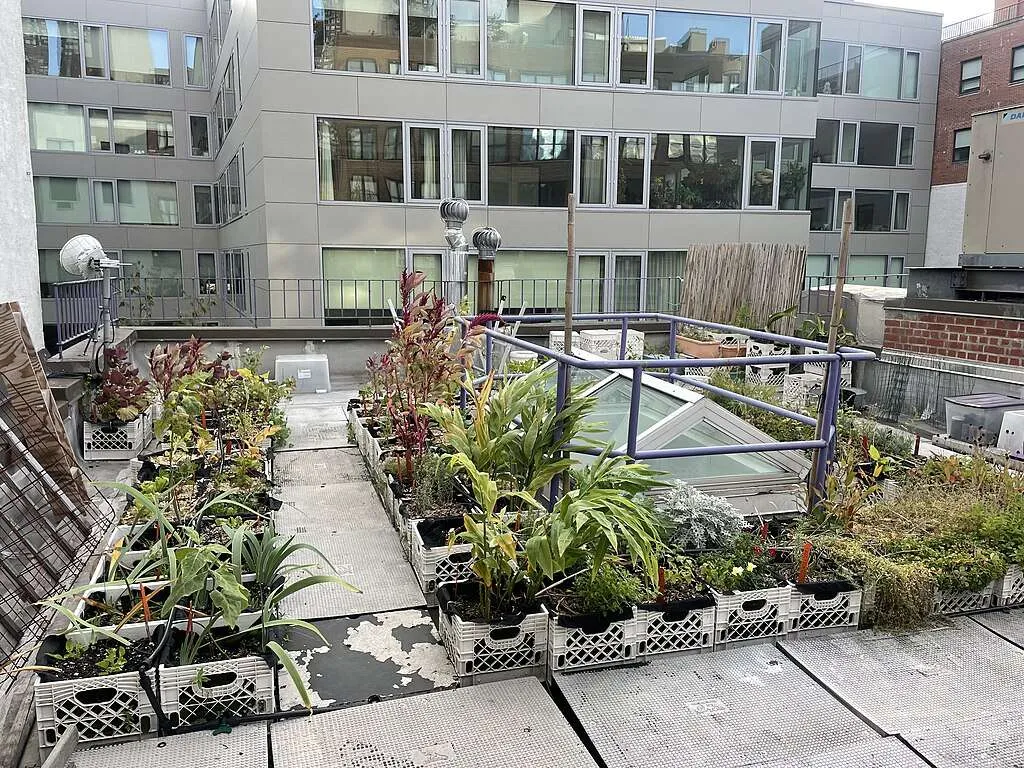
Rooftop gardens are a growing trend in urban landscaping, offering a blend of beauty and functionality. But are they the right choice for everyone?
This section explores the multifaceted benefits, advantages, and practical considerations involved, helping you determine if a rooftop garden aligns with your lifestyle and objectives.
Benefits of Rooftop Gardens:
-
- Environmental Benefits: These gardens contribute significantly to the environment by enhancing urban biodiversity, reducing heat island effects, improving air quality, and managing stormwater runoff. They act as natural insulators, potentially lowering energy costs.
- Aesthetic Enhancement: Rooftop gardens transform dull, unused spaces into vibrant, green sanctuaries. They add visual appeal to buildings, creating an attractive view for both residents and neighbors.
- Personal Well-Being: They provide a private retreat in busy urban settings, promoting relaxation and mental well-being. Gardening activities themselves can be therapeutic and physically rewarding.
- Community and Social Value: Rooftop gardens can foster community engagement and offer a communal space for social interactions, especially in shared residential or commercial buildings.
Considerations for Rooftop Gardens:
-
- Structural Integrity: The foremost consideration is the structural capacity of your roof. Consulting with a structural engineer or architect is vital to ensure that your roof can safely support the additional weight of the garden.
- Accessibility and Safety: Ensure that the rooftop is easily accessible and complies with safety regulations, including secure railings and non-slip surfaces.
- Maintenance Requirements: Regular maintenance is crucial for the health of your garden. Consider the time and resources needed for tasks like watering, weeding, pruning, and pest control.
- Cost Implications: Setting up a rooftop garden can be an investment. Factors such as waterproofing, container purchases, soil, plants, and irrigation systems contribute to the initial costs.
- Weather and Environmental Challenges: Rooftop gardens face more extreme weather conditions than ground-level gardens. Selecting the right plants and designing the garden to withstand wind, sun exposure, and temperature fluctuations is essential.
- Legal and Regulatory Compliance: Check local zoning laws and building codes, as some areas may have specific regulations or require permits for rooftop gardens.
While rooftop gardens offer a range of benefits, from environmental improvements to personal relaxation spaces, they also come with their own set of challenges.
Understanding these can help you make a well-informed decision about whether a rooftop garden is a good idea for your specific situation.
With careful planning and consideration, a rooftop garden can be a rewarding addition to urban living.
Techniques for Rooftop Gardening
Rooftop gardening is an art that combines traditional gardening practices with innovative techniques suited to high-altitude environments. This section is dedicated to providing you with practical tips and strategies to help you cultivate a thriving garden on your rooftop, regardless of its size or structure.
Container Gardening:
-
- Choosing Containers: Select containers that are lightweight yet durable. Consider materials like fiberglass, resin, or high-quality plastics that can withstand sun exposure and temperature changes.
- Soil Selection: Use a high-quality potting mix that provides good drainage and nutrient retention. Avoid using garden soil as it can be too dense and may contain pests or diseases.
- Plant Arrangement: Arrange plants based on their sun and water needs. Grouping plants with similar requirements together makes maintenance easier.
- Mobility: Consider using containers with casters or platforms to easily move plants around for sun exposure or shelter during extreme weather.
Vertical Gardening:
-
- Optimizing Space: Vertical gardening is an excellent way to maximize limited rooftop space. By growing plants upwards rather than outwards, you can create a lush garden without overcrowding the roof.
- Using Vertical Structures: Utilize structures like trellises, wall planters, and hanging baskets to support vines and climbing plants. This not only adds dimension to your garden but also can provide privacy and wind protection.
- Plant Selection: Choose plants that naturally climb or can be easily trained to grow vertically, such as ivy, climbing roses, or certain vegetables like beans and cucumbers.
- Maintenance Considerations: Ensure that your vertical structures are securely anchored to withstand windy conditions typical of rooftop settings. Regular pruning and training of plants will also be necessary to maintain the vertical garden’s aesthetic and health.
Incorporating vertical gardening into your rooftop space opens up a new dimension of urban gardening.
It’s an innovative and efficient way to expand your planting area, enhance privacy, and add an artistic touch to your rooftop oasis.
With the right structures and plant choices, vertical gardens can turn an ordinary rooftop into a stunning vertical landscape.
Water Management:
-
- Irrigation Systems: Install an automated drip irrigation system to ensure consistent and efficient watering. This is particularly important for rooftop gardens due to increased exposure and potential for rapid drying.
- Water Conservation: Utilize water-conserving practices such as mulching to retain moisture. Collecting rainwater is also an eco-friendly option for watering your plants.
- Monitoring Moisture: Regularly check soil moisture and adjust your watering schedule accordingly. Rooftop gardens may require more frequent watering, especially during hot or windy days.
Plant Care:
-
- Wind Protection: Use windbreaks such as trellises, lattice screens, or taller plants to protect more delicate species from strong winds.
- Pest Control: Keep an eye out for pests common in rooftop settings. Use environmentally friendly pest control methods like neem oil or insecticidal soap.
- Seasonal Adjustments: Adapt your care routine to the seasons. In hot summers, increase watering and provide shade if necessary. In winter, consider moving sensitive plants indoors or providing covers to protect them from frost.
- Fertilization: Regular feeding is key to the health of your rooftop garden. Use a balanced, slow-release fertilizer to provide your plants with the necessary nutrients.
Rooftop gardening, with its unique challenges, also brings immense satisfaction and beauty.
By mastering the techniques of container gardening, efficient water management, and proper plant care, you can transform your rooftop into a flourishing green space.
Remember, patience and adaptability are your best tools in nurturing a garden that sits above the rest.
The Main Idea of Rooftop Gardening
Rooftop gardening is more than just planting on a high surface; it’s a transformative approach to urban living and sustainability.
This expanded section aims to shed light on the fundamental principles and objectives that drive the concept of rooftop gardening, emphasizing its impact on urban greening and sustainable practices.
Urban Greening:
-
- Maximizing Underused Spaces: Rooftop gardens turn underutilized urban spaces into vibrant, green areas. They are a creative solution to the scarcity of green spaces in densely populated cities.
- Improving Urban Ecology: By introducing more plants into the urban environment, rooftop gardens enhance local biodiversity, providing habitats for birds, insects, and other wildlife.
- Reducing Urban Heat Island Effect: These gardens help mitigate the urban heat island effect by absorbing sunlight and cooling the air, thus contributing to a more pleasant urban microclimate.
- Beautifying Cityscapes: Rooftop gardens add aesthetic value to the urban landscape, transforming stark rooftops into visually appealing, lush environments.
Sustainability:
-
- Environmental Benefits: Rooftop gardens play a significant role in environmental conservation. They contribute to air purification, carbon sequestration, and stormwater management.
- Resource Efficiency: These gardens often utilize recycled materials, rainwater harvesting, and composting, exemplifying efficient resource use and waste reduction.
- Energy Conservation: By providing insulation, rooftop gardens can reduce the energy needed for heating and cooling buildings, leading to lower carbon emissions and energy costs.
- Promoting Sustainable Lifestyles: Rooftop gardens encourage a closer connection with nature and a greater awareness of environmental issues. They serve as a platform for education and engagement in sustainable practices.
The essence of rooftop gardening lies in its ability to blend functionality with ecological sensitivity.
It’s a progressive approach that addresses several urban challenges, offering a path towards more sustainable and resilient cities.
Whether it’s through the creation of green oases in concrete jungles or the promotion of eco-friendly practices, rooftop gardening is an impactful, innovative solution that enhances both the environment and the quality of urban life.
Problems Solved by Rooftop Gardens
In the face of growing urbanization and environmental concerns, rooftop gardens emerge as innovative solutions to several key urban challenges.
This section delves into how rooftop gardens are not just ornamental features but functional assets that address and mitigate pressing urban problems.
Combating the Urban Heat Island Effect:
-
- Temperature Regulation: Rooftop gardens play a crucial role in reducing the urban heat island effect. They absorb and use the sun’s rays for photosynthesis rather than allowing them to hit hard, dark surfaces that absorb and radiate heat.
- Cooling Properties: The process of evapotranspiration from plants in rooftop gardens helps cool the surrounding air, leading to a reduction in ambient temperatures in urban areas.
- Insulation: These gardens provide natural insulation for buildings, reducing the need for artificial cooling and heating, thus cutting down on energy consumption and associated emissions.
Creating Green Spaces in Urban Areas:
-
- Expanding Green Footprint: In cities where ground space is limited, rooftop gardens create valuable green areas. They effectively utilize otherwise unused spaces, adding to the city’s overall green footprint.
- Enhancing Quality of Life: By providing pockets of nature in urban settings, rooftop gardens improve the aesthetic appeal of the cityscape and offer residents spaces for relaxation and recreation.
- Social and Community Benefits: These gardens can serve as communal spaces for urban dwellers, promoting social interaction and community cohesion. They can also be used for educational and recreational activities, further enhancing their value to urban communities.
Improving Air Quality and Biodiversity:
-
- Air Purification: Rooftop gardens contribute to cleaner air by filtering pollutants and particulate matter, which is especially significant in cities with high levels of pollution.
- Supporting Urban Wildlife: By introducing a variety of plant species, rooftop gardens become habitats for birds, bees, and other beneficial insects, contributing to urban biodiversity and ecological balance.
Read more: Urban Beekeeping on Rooftops
Stormwater Management:
-
- Absorbing Rainwater: These gardens can absorb and retain rainwater, reducing runoff and easing the pressure on urban drainage systems. This is particularly important in preventing flooding and waterlogging in cities.
- Water Quality Improvement: By filtering rainwater, rooftop gardens can also help improve the quality of water that eventually enters the drainage systems.
Rooftop gardens are much more than aesthetic additions to the urban landscape; they are practical solutions to some of the most pressing urban challenges.
From mitigating the heat island effect to creating vital green spaces and improving air quality, these rooftop gardens are important and represent a powerful tool in the quest for more sustainable and livable urban environments.
Environmental Impact of Rooftop Gardens
Rooftop gardens have garnered attention not just for their aesthetic appeal but for their potential environmental impact.
This section takes a closer look at how these green spaces interact with the urban ecosystem, evaluating both their positive contributions and the challenges they may present.
Positive Impacts of Rooftop Gardens:
-
- Biodiversity Enhancement: Rooftop gardens create new habitats for a variety of species, including birds, bees, and butterflies, thus increasing urban biodiversity. They serve as crucial stepping stones for wildlife in city environments.
- Air Quality Improvement: By incorporating plants and greenery, rooftop gardens contribute to filtering out airborne pollutants and releasing oxygen, leading to improved air quality.
- Reduction of Urban Heat Island Effect: These gardens play a significant role in mitigating the urban heat island effect. The vegetation helps cool the air through shading and evapotranspiration, reducing the overall temperature in urban areas.
- Stormwater Management: Rooftop gardens absorb and slow down rainwater runoff, easing the burden on urban drainage systems and reducing the risk of flooding.
- Energy Efficiency: By providing natural insulation, these gardens can lower the energy demand for heating and cooling buildings, contributing to a reduction in greenhouse gas emissions.
Considerations and Challenges:
-
- Water Usage: One of the challenges of rooftop gardens is the potential for high water usage. To mitigate this, it’s important to implement efficient irrigation systems, such as drip irrigation, and to choose drought-tolerant plants.
- Structural Load and Maintenance: The additional weight and maintenance requirements of rooftop gardens can be a concern. It’s crucial to ensure that buildings can structurally support these gardens and to plan for regular upkeep.
- Construction and Material Use: The construction phase of rooftop gardens, including the materials used, can have environmental impacts. Using recycled and sustainable materials, as well as local plants, can help minimize this footprint.
- Long-Term Sustainability: Ensuring the long-term sustainability of rooftop gardens is essential. This includes considering the lifecycle of the garden and planning for ongoing care and potential environmental changes.
The environmental impact of rooftop gardens is predominantly positive, contributing significantly to urban sustainability and ecological balance.
While there are challenges and considerations, with careful planning and responsible management, rooftop gardens can be a powerful tool in making cities greener and more environmentally friendly.
Key Considerations for Rooftop Gardening
Rooftop gardening presents a unique blend of challenges and opportunities.
To create a sustainable and thriving garden in the sky, it’s essential to understand and address the specific needs of a rooftop environment.
This section expands on the key considerations to keep in mind as you embark on this exciting gardening adventure.
Weight Capacity:
-
- Structural Assessment: It’s crucial to start with a structural assessment of your roof. This involves determining the weight it can safely bear, considering not just the weight of planters and soil, but also additional elements like furniture, water features, and people.
- Consulting Experts: Seeking the advice of an architect, structural engineer, or building manager can provide valuable insights into what your rooftop can handle and help prevent any potential risks.
- Weight Distribution: Plan your garden layout to evenly distribute weight across the roof surface. Avoid clustering heavy items in one spot, which could create pressure points.
Plant Selection:
-
- Wind and Sun Tolerance: Look for plants that are not just aesthetically pleasing but also resilient to the rooftop’s harsher conditions. Wind-tolerant plants and those that thrive in full sun are typically good choices.
- Container Gardening: Consider growing plants in containers, which allows for better control over soil quality and makes it easier to shift plants around if needed.
- Diversity: Incorporate a variety of plants, including perennials, annuals, and even small shrubs or trees. This diversity can create a more visually appealing and ecologically balanced garden.
Water and Soil Management:
-
- Lightweight Soil: Opt for high-quality, lightweight potting mixes specifically designed for container gardening. These mixes promote good drainage and aeration, crucial for plant health.
- Irrigation Strategies: A drip irrigation system is ideal for ensuring consistent and efficient watering. It can be automated to reduce the burden of daily watering, a must for busy urban gardeners.
- Drainage Considerations: Ensure proper drainage in your planters and across your rooftop. Poor drainage can lead to waterlogging, which can damage both the plants and the roof structure.
Accessibility and Maintenance:
-
- Easy Access: Design your garden so it’s easy to access for maintenance, watering, and enjoyment. Pathways, stepping stones, or decking can create navigable routes through your garden.
- Ongoing Maintenance: Plan for regular maintenance tasks, including pruning, fertilizing, and pest control. A rooftop garden, like any garden, requires ongoing care to thrive.
Establishing a rooftop garden is a rewarding endeavor that enhances urban living spaces.
By carefully considering factors like weight capacity, plant selection, and water and soil management, you can create a stunning and sustainable garden that rises above the city.
Remember, a successful rooftop garden blends functionality with creativity, resulting in a space that’s not only beautiful but also a testament to smart urban gardening practices.
Rooftop Garden Utilities and Safety
While the allure of rooftop gardens often lies in their visual and environmental appeal, the practical aspects of utilities and safety are equally crucial.
A successful rooftop garden not only thrives in terms of plant health and aesthetics but also functions safely and efficiently.
This expanded section explores the essential utilities needed for rooftop gardening and the vital safety measures that must be in place.
Water Accessibility:
-
- Water Source: Having a reliable water source is crucial. An outdoor tap or a connection to your building’s water supply is ideal. In the absence of a tap, consider installing a water storage system like rain barrels.
- Irrigation System: Given the exposure to sun and wind, rooftop gardens often require more frequent watering. An automated drip irrigation system can be a significant time-saver. It ensures consistent moisture levels, which is vital for plant health and can be adjusted as per the needs of different plants.
- Water Efficiency: Look into water-efficient irrigation methods, like soaker hoses or drip lines. These systems minimize water waste and are more sustainable.
Electrical Access:
-
- Lighting Needs: If you plan to use your rooftop garden during the evening, outdoor lighting is essential. This includes ambient lighting for atmosphere and esthetics and task lighting for functional areas like dining or cooking spaces.
- Power Requirements: Assess the power requirements for your garden, and ensure you have adequate outdoor electrical outlets. If not, you might need to install weatherproof outlets or use solar-powered options.
- Electrical Safety: Ensure all electrical installations are done by a qualified electrician and comply with safety standards. Use outdoor-rated fixtures and cables to withstand weather conditions.
Safety First:
-
- Railings and Barriers: Check that existing railings are sturdy and meet local height requirements. If your rooftop lacks railings, installing them should be a priority to prevent falls.
- Non-Flammable Materials: Be cautious about using flammable materials in your rooftop garden. Choose non-flammable containers, furniture, and decor to reduce fire risk.
- Wind Considerations: Secure lightweight items to prevent them from being blown over or away. This includes planters, furniture, and decor items.
- Regular Inspections: Regularly inspect your rooftop garden for potential hazards, including loose railings, electrical issues, or water leaks. Addressing these issues promptly can prevent accidents and ensure a safe gardening experience.
Integrating the right utilities and prioritizing safety is fundamental to the success and enjoyment of your rooftop garden.
By ensuring efficient water and electrical access and adhering to safety standards, you create not only a beautiful but also a functional and secure green space atop your urban dwelling.
Remember, a well-maintained rooftop garden is a safe and sustainable extension of your home.
Designing Your Rooftop Garden
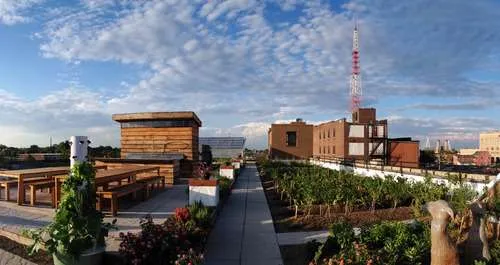
Crafting a rooftop garden is a blend of artistry and practicality. It’s about creating a space that not only looks beautiful but is also functional and sustainable. This section dives deeper into how you can design a rooftop garden that’s a reflection of your personal style while being mindful of the unique challenges of rooftop spaces.
Maximizing Views:
-
- Strategic Plantings: Use plants to your advantage. Position tall evergreens or bamboo to shield against unsightly views or to create privacy barriers. For areas with attractive views, consider using lower-growing plants or even ground covers that don’t obstruct the sightlines.
- Focal Points: Identify and create focal points using unique plant species, garden sculptures, or water features. These elements can draw the eye and add interest to your rooftop garden.
- Zoning: Divide your rooftop into different zones – a dining area, a relaxation corner, and a green space. This zoning can enhance the functionality of your rooftop garden and make it more inviting.
Lighting and Shade:
-
- Ambient Lighting: Incorporate a mix of lighting options. Soft, ambient lights can create a relaxing atmosphere for evening enjoyment. Solar-powered lights are an eco-friendly option and can be easily installed.
- Task Lighting: For areas like dining or cooking spaces, consider brighter, more focused lighting.
- Shade Structures: In addition to pergolas and awnings, consider retractable options for flexibility. Shade sails are a modern, stylish choice that can protect from the sun while adding a design element to your garden.
- Natural Shade: Utilize plants to create shade. Tall plants or trellises with climbing vines can offer natural shade and add greenery.
Furniture and Features:
-
- Furniture Selection: Choose furniture that’s not only lightweight and durable but also reflects the style of your garden. Consider materials like rattan, aluminum, or recycled plastics. Folding or stackable furniture can be a practical choice for smaller spaces.
- Fire Pits and Jacuzzis: If considering a fire pit or Jacuzzi, first ensure they are permissible and safe according to local regulations. For fire pits, portable, smokeless options could be ideal. When it comes to Jacuzzis, check the weight tolerance of your roof and consult professionals for installation.
- Additional Features: Consider adding other features like vertical gardens or green walls, which are not only visually striking but also space-efficient. Water features like small fountains or bird baths can add a soothing element to your garden.
Designing a rooftop garden is a rewarding endeavor that allows for creativity and personal expression.
By thoughtfully considering views, lighting, shade, and furniture, your rooftop can be transformed into a stunning and functional green retreat.
Remember, each element should not only be aesthetically pleasing but also cater to the unique conditions of a rooftop setting.
With careful planning and a touch of creativity, your rooftop garden can become a cherished extension of your living space.
The Benefits of Building a Rooftop Garden
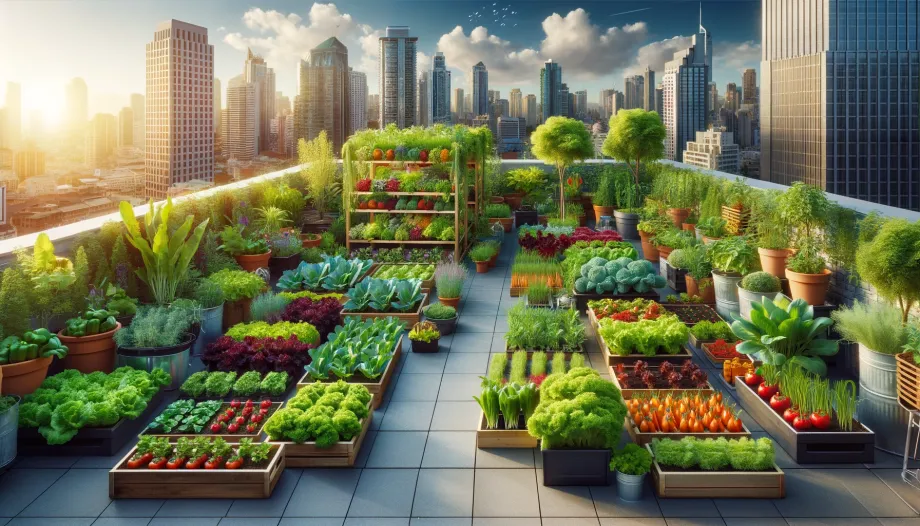
While the aesthetic appeal of rooftop gardens is undeniable, their value extends far beyond just good looks.
These green spaces serve as critical components in urban sustainability and personal well-being.
This section explores the multifaceted benefits of rooftop gardens, highlighting how they contribute positively to both our environment and our lives.
Environmental Impact:
-
- Stormwater Management: Rooftop gardens play a crucial role in managing stormwater in urban areas. They absorb rainwater, reducing runoff that can lead to flooding and pollution in waterways.
- Temperature Regulation: By providing insulation, rooftop gardens can significantly reduce the need for air conditioning in the summer and heating in the winter, leading to lower energy consumption and costs.
- Air Quality Improvement: Plants in rooftop gardens filter airborne pollutants and release oxygen, contributing to cleaner and healthier urban air.
- Biodiversity: Rooftop gardens create habitats for a variety of wildlife, including birds, bees, and butterflies. This biodiversity is essential for pollination and maintaining ecological balance in urban settings.
- Urban Heat Island Effect Reduction: Rooftop gardens can mitigate the urban heat island effect, a phenomenon where urban areas are significantly warmer than their rural surroundings due to human activities.
Personal Benefits:
-
- Mental Health and Well-being: Spending time in green spaces, like rooftop gardens, has been shown to reduce stress, improve mood, and enhance overall mental health.
- Social Space: Rooftop gardens provide a unique setting for socializing, whether it’s casual get-togethers, family meals, or hosting events. They offer a refreshing change from indoor environments.
- Physical Activity: Gardening activities can be a form of physical exercise, promoting health and wellness.
- Homegrown Produce: For those interested in food sustainability, rooftop gardens offer the opportunity to grow your own fruits, vegetables, and herbs. This not only provides fresh produce but also connects you more intimately with your food source.
- Educational Opportunities: Rooftop gardens can be educational spaces for children and adults alike, teaching valuable lessons about nature, sustainability, and the importance of green spaces in urban areas.
The benefits of building a rooftop garden are extensive and impactful.
They offer a practical solution to environmental challenges in urban areas and provide a personal sanctuary for relaxation and enjoyment.
By cultivating a rooftop garden, you are not only enhancing your living space but also contributing positively to the urban ecosystem.
These gardens are a testament to how small changes in our lifestyle can have a significant positive impact on both our well-being and the environment.
Special Design Considerations for Rooftop Gardens
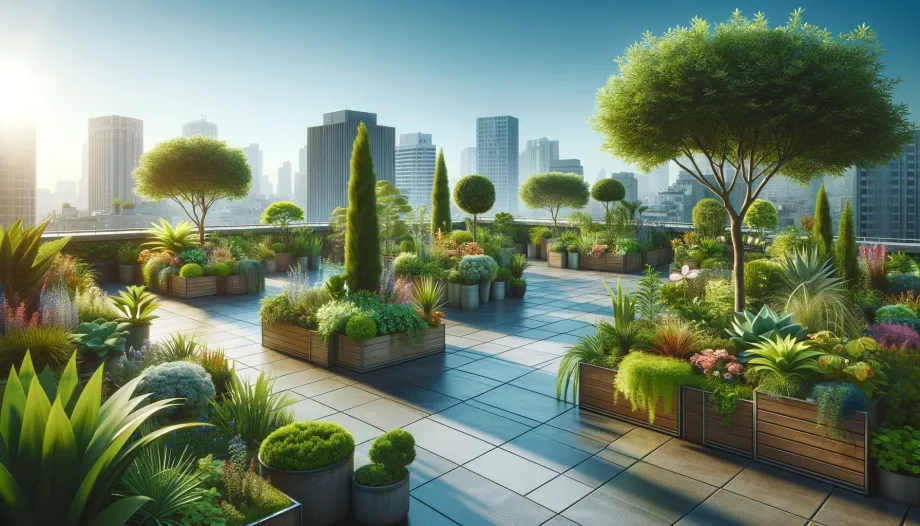
Crafting a successful rooftop garden requires attention to details that might not be as critical in traditional ground-level gardening.
This section delves deeper into the unique considerations necessary for creating a thriving rooftop garden that withstands the challenges of an elevated environment and maximizes its potential.
Climate Challenges:
-
- Wind Resilience: Rooftops often face stronger winds than ground-level gardens. Selecting wind-resistant plants and using windbreaks, like lattice screens, can protect more delicate plants.
- Sunlight Management: Rooftops can experience more intense sunlight. Understanding the sun exposure your rooftop receives is crucial for choosing the right plants and positioning them for optimal growth.
- Temperature Extremes: Rooftops can be hotter during summer and colder in winter. Opt for plants that can tolerate these extremes. Consider using insulating materials in planters to protect roots from temperature fluctuations.
Soil and Plant Protection:
-
- Lightweight Soil Mixes: Standard garden soil is too heavy and can retain excess water, posing a risk to the structural integrity of the roof. Using a lightweight, well-draining soil mix helps prevent this issue.
- Root Protection: In addition to insulating plant roots from temperature extremes, ensure that the soil provides adequate nutrients. Regularly replenishing or supplementing the soil can keep your rooftop garden healthy.
Water Management:
-
- Irrigation Systems: Given the exposure to sun and wind, rooftop plants may require more frequent watering. An automatic drip irrigation system can be a lifesaver, ensuring consistent and efficient watering.
- Drainage: Proper drainage is critical. Ensure that your planters and garden layout allow for adequate water runoff without causing pooling or structural damage.
Legal and Structural Considerations:
-
- Building Regulations: Before starting your rooftop garden, check local building codes and regulations. Some areas may have restrictions or require permits.
- Professional Assessment: It’s advisable to consult with an architect or structural engineer to assess your roof’s capacity and any modifications needed to accommodate your garden safely.
Designing for Aesthetics and Function:
-
- Visual Appeal: Consider the visual aspects of your garden from both the rooftop and from ground level. A well-designed rooftop garden can enhance the appearance of your building.
- Functionality: Your garden should be more than just pretty. Think about how you will use the space and design for those activities, whether it’s relaxing, entertaining, or gardening.
Designing a rooftop garden comes with its set of challenges but also offers immense rewards.
By carefully considering the unique aspects of rooftop environments and addressing them thoughtfully in your design, you can create a stunning, sustainable, and enjoyable green space atop your urban dwelling.
Remember, a well-planned rooftop garden is not only a personal retreat but also a contribution to the greening of urban landscapes.
FAQs on Rooftop Gardening
Starting a rooftop gardening project often comes with a host of questions, especially for beginners and even for seasoned gardeners exploring this unique gardening space.
In this FAQ section, we’ll address some of the most common inquiries about rooftop gardening.
From the basics of getting started to specific gardening tips, these answers aim to clarify doubts and provide valuable insights to help you create a flourishing rooftop garden, regardless of its size or style.
Q: Can I have a garden on my rooftop?
A: Absolutely! With the right planning and design, you can transform your rooftop into a garden.
It’s crucial to first check the weight-bearing capacity of your roof to ensure it can support your garden plans.
Whether you’re interested in a green roof with low-maintenance plants or a more traditional roof garden with a variety of vegetation and outdoor furnishings, there’s a rooftop gardening solution for almost every type of building.
Just remember, a successful rooftop garden starts with understanding the unique requirements of gardening at an elevated level.
Q: What are the benefits of having a rooftop garden?
A: Rooftop gardens offer a myriad of benefits. They can significantly reduce stormwater runoff, lower heating and cooling costs, improve air quality, and provide habitats for urban wildlife like birds and bees.
On a personal level, they offer a serene space to relax and unwind, enhance the beauty of your living environment, and even offer the opportunity to grow your own food.
Q: How can I create a rooftop vegetable garden?
A: Creating a rooftop vegetable garden involves choosing the right containers, selecting suitable vegetable varieties, and ensuring adequate sunlight and water.
Lightweight containers and soil are essential to avoid overburdening your roof.
Focus on vegetables that thrive in containers and consider factors like sun exposure and wind when planning your garden layout.
Also, consider setting up an efficient watering system to maintain a consistent moisture level, crucial for vegetable growth.
Q: How can I keep the weight of my rooftop garden manageable?
A: To manage weight, use lightweight materials like pre-fabricated wood, fiberglass, or metal planters.
Opt for custom planters with false bottoms to reduce soil volume. Terracotta pots are heavy and can crack. Use plastic or wood planters instead.
Coco coir is a lightweight medium that weighs half as much as potting soil. It also allows you to reduce planter size by one-third because it is more efficient.
For decking, choose lighter materials like wood over porcelain and heavier stone or concrete.
Q: What utilities are essential for a rooftop garden?
A: Essential utilities include an outdoor faucet for watering and an electrical outlet for landscape lighting.
Investing in an automated drip irrigation system can be a game-changer for water management and plant health.
Q: What safety considerations should I keep in mind for my rooftop garden?
A: Ensure railing heights comply with local laws. Be cautious with flammable materials, and if using umbrellas, opt for wind-rated ones with heavy bases for safety against strong winds.
Q: What types of plants are best suited for rooftop gardens?
A: Choose plants that are more bottom-heavy to resist wind. Evergreens, multi-stem, and weeping trees are excellent choices.
Avoid plants with large leaves that can be damaged by wind, and select species according to the sunlight received.
Q: How should I handle views in my rooftop garden design?
A: Garden design ideas and tips are to block unattractive views with tall plantings or fencing, and maintain open views in attractive areas with lower plantings.
The strategic placement of plants can enhance the aesthetic appeal of your rooftop garden.
Q: Can I include features like fire pits and Jacuzzis in my rooftop garden?
A: Yes, but comply with local fire code rules. Electric grills or dedicated gas lines are usually allowed.
For Jacuzzis, ensure your roof can support the weight, and consider the logistics of installation.
Conclusion: Embracing the Skyline with Rooftop Gardening Ideas
As urban living spaces become increasingly compact, rooftop gardens emerge as a creative solution to reconnect with nature.
They offer a unique blend of functionality and beauty, transforming unused spaces into vibrant green havens.
- Combining Aesthetics and Sustainability: Rooftop gardens are not just about aesthetic enhancement; they’re a sustainable step towards urban greening. They contribute to better air quality, reduce energy costs, and support biodiversity.
- Personal Oasis in Urban Settings: Whether it’s a small terrace with a few potted plants or an expansive rooftop vegetable garden, these spaces provide a personal retreat, a place to relax and enjoy nature’s beauty amidst the urban landscape.
- A Canvas for Creativity: The rooftop garden is a canvas for creativity, allowing you to experiment with rooftop garden design ideas, plants, and features. It’s an ongoing project that evolves with your tastes and needs, offering endless possibilities for personalization and enjoyment.
In conclusion, rooftop gardening is more than just a trend; it’s a lifestyle choice that brings environmental benefits, personal satisfaction, and a touch of green to our urban environments.
Whether you’re a seasoned gardener or a curious newbie, the sky’s the limit when it comes to cultivating your rooftop garden.
Read more: How Green Roofs Work: 5 Little-known Ways
Visit my Amazon Influencer Page for videos and gardening products Grow Your Own Garden





